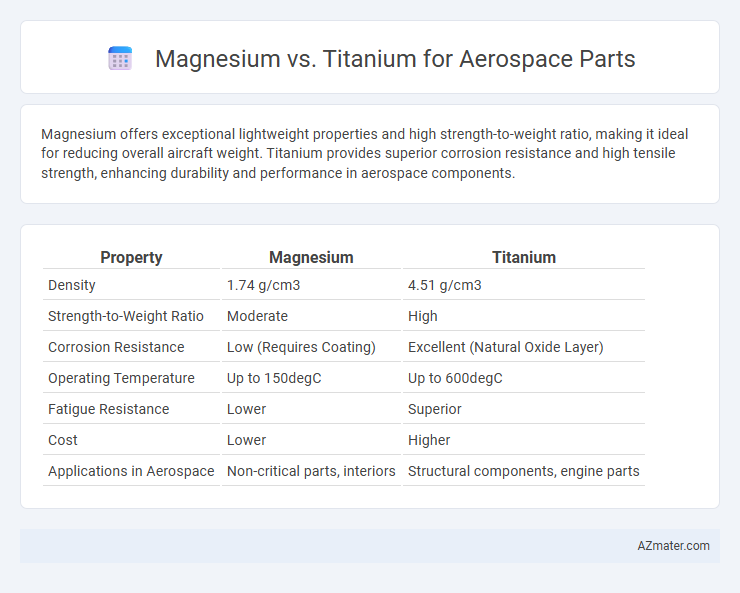Magnesium offers exceptional lightweight properties and high strength-to-weight ratio, making it ideal for reducing overall aircraft weight. Titanium provides superior corrosion resistance and high tensile strength, enhancing durability and performance in aerospace components.
Table of Comparison
| Property | Magnesium | Titanium |
|---|---|---|
| Density | 1.74 g/cm3 | 4.51 g/cm3 |
| Strength-to-Weight Ratio | Moderate | High |
| Corrosion Resistance | Low (Requires Coating) | Excellent (Natural Oxide Layer) |
| Operating Temperature | Up to 150degC | Up to 600degC |
| Fatigue Resistance | Lower | Superior |
| Cost | Lower | Higher |
| Applications in Aerospace | Non-critical parts, interiors | Structural components, engine parts |
Introduction: Magnesium vs Titanium in Aerospace
Magnesium and titanium are critical materials in aerospace manufacturing due to their unique properties. Magnesium offers lightweight advantages with excellent strength-to-weight ratio, reducing overall aircraft weight and improving fuel efficiency. Titanium provides superior corrosion resistance, high strength, and durability under extreme temperatures, making it ideal for structural components and engine parts in aerospace applications.
Material Properties Overview
Magnesium offers high strength-to-weight ratio and excellent machinability, making it ideal for lightweight aerospace components where weight reduction is critical. Titanium provides superior corrosion resistance, higher tensile strength, and better fatigue performance, suitable for high-stress aerospace parts exposed to extreme environments. The choice between magnesium and titanium depends on balancing weight savings with mechanical durability and environmental resistance specific to aerospace applications.
Weight Comparison: Magnesium vs Titanium
Magnesium weighs approximately 1.74 g/cm3, making it about 35% lighter than titanium, which has a density of around 4.51 g/cm3. This significant weight difference positions magnesium as a preferred choice for aerospace parts where minimizing mass is critical for fuel efficiency and performance. However, titanium's superior strength-to-weight ratio often balances its higher density in applications requiring enhanced durability and structural integrity.
Strength and Durability
Magnesium alloys offer lightweight properties with moderate strength, making them suitable for reducing overall aircraft weight but less ideal in high-stress aerospace applications. Titanium exhibits superior strength-to-weight ratio and exceptional resistance to fatigue, corrosion, and high temperatures, enhancing the durability of critical aerospace components. Choosing titanium over magnesium ensures enhanced structural integrity and longevity in demanding aerospace environments.
Corrosion Resistance and Protection
Magnesium alloys offer lightweight benefits but exhibit lower corrosion resistance compared to titanium, often requiring protective coatings such as anodizing or conversion coatings to enhance durability in aerospace environments. Titanium displays superior corrosion resistance due to its stable oxide layer, providing intrinsic protection against oxidation and various corrosive agents without heavy reliance on external treatments. The selection between magnesium and titanium hinges on balancing weight savings against long-term corrosion performance and maintenance demands in aerospace applications.
Machinability and Fabrication
Magnesium offers superior machinability compared to titanium, allowing faster cutting speeds and reduced tool wear, which enhances manufacturing efficiency for aerospace parts. Titanium, while more challenging to machine due to its hardness and tendency to work-harden, provides exceptional strength-to-weight ratio and corrosion resistance, critical for high-performance aerospace components. Fabrication of magnesium benefits from lower energy consumption and ease of forming, whereas titanium requires more advanced techniques such as specialized cutting tools and controlled environments to prevent contamination and ensure dimensional precision.
Cost and Availability Factors
Magnesium offers a lower material cost and lighter weight compared to titanium, making it advantageous for budget-sensitive aerospace applications where reducing overall aircraft weight is critical. Titanium, while significantly more expensive and less abundant, provides superior strength-to-weight ratio and corrosion resistance, contributing to longer lifecycle and lower maintenance costs. Availability of magnesium is generally higher due to its abundance and simpler extraction process, whereas titanium sourcing involves complex refining, impacting lead times and initial investment.
Applications in Aerospace Components
Magnesium alloys are favored in aerospace components for their exceptional lightweight properties, reducing overall aircraft weight and improving fuel efficiency. Titanium's superior strength-to-weight ratio and excellent corrosion resistance make it ideal for critical structural parts exposed to high stress and extreme temperatures. Aerospace applications frequently combine magnesium for non-structural, lightweight panels and titanium for load-bearing frames, engine components, and fasteners, optimizing performance and durability.
Environmental and Safety Considerations
Magnesium alloys offer lightweight benefits for aerospace parts but pose higher flammability risks and require stringent handling to mitigate fire hazards. Titanium, while heavier, provides superior corrosion resistance, non-flammability in typical conditions, and contributes to safer maintenance and longer service life. Environmental impact favors titanium due to its recyclability and lower oxidative degradation compared to magnesium's reactive nature and energy-intensive protective coatings.
Conclusion: Choosing the Right Material
Selecting between magnesium and titanium for aerospace parts hinges on balancing weight, strength, and corrosion resistance. Titanium offers superior strength-to-weight ratio and excellent corrosion resistance, ideal for critical structural components exposed to harsh conditions. Magnesium provides significant weight savings with adequate strength but requires protective coatings to prevent corrosion, making it suitable for less stressed parts where weight reduction is paramount.

Infographic: Magnesium vs Titanium for Aerospace Part
 azmater.com
azmater.com